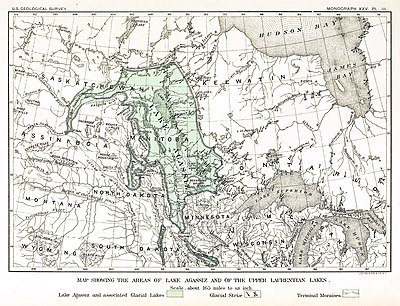Lake Agassiz

Lake Agassiz was an immense glacial lake located in the center of North America. As such, it was fed by glacial runoff at the end of the last ice age which accumulated into a huge lake that was bigger than all of the present-day Great Lakes combined.
Conception
First postulated in 1823 by William Keating, it was named after Louis Agassiz in 1879 after he was the first to realize it was formed by glacial action.
Geological progression
Geologists have come to a consensus on the likely geological progression of Lake Agassiz.
The lake's modern-day remnants, the largest of which is Lake Winnipeg, dominate the geography of Manitoba. Forming around 13,000 calendar years before present (almost 12,000 14C years before present), the lake came to cover much of Manitoba, western Ontario, northern Minnesota, eastern North Dakota, and Saskatchewan. At its greatest extent it may have covered as much as 440,000 square kilometers, larger than any lake currently in the world, or even the Caspian Sea. This is roughly the size of Iraq, the 58th largest country in the world, larger than California, the third largest U.S. state, and smaller than the Yukon, the ninth largest Canadian territory or province.
The lake drained at various times south through the Traverse Gap into Glacial River Warren (parent to the Minnesota River, a tributary of the Mississippi River), into the Great Lakes, or west through the Yukon Territory and Alaska. Climatologists believe that a major outbreak of Lake Agassiz in about 11000 BC drained through the Great Lakes and Saint Lawrence River into the Atlantic Ocean. A return of the ice for some time offered a reprieve, and after retreating north of the Canadian border about 9,900 years ago it refilled. These events had significant impact on climate, sea level and possible early human civilizations in the Younger Dryas event.
The last major shift in drainage occurred about 8,400 calendar years before present (about 7,700 14C years before present), when the lake took up its current watershed, that of Hudson Bay. The lake drained nearly completely over the next 1,000 years or so, leaving behind Lake Winnipeg, Lake Winnipegosis, Lake Manitoba, and Lake of the Woods, among others. The outlines and volumes of these lakes are still slowly changing due to differential isostatic rebound. Much of the final drainage of Lake Agassiz may have occurred in a very short time—perhaps as little as one year. Recent studies by British scientist Chris Turney links this rapid drainage and subsequent global sea level rise of about one meter to the expansion of agriculture in Europe, as well as the various flood myths of prehistoric cultures including the biblical flood.[1][2]
While mostly gone along with the ice sheet that fed it, Lake Agassiz left marks over a large geographic area. Apparent beaches, kilometers or miles from any water, can be found in many locations—these mark the former boundaries of the lake. Several modern river valleys, including the Red River, the Assiniboine River and the aforementioned Minnesota River, were originally cut by water entering or leaving the lake. The Red River Valley agricultural region also exists because of the silt that sank to the bottom of the lake.
See also
References
Notes
- ^ Turney, C.S.M. and Brown, H. (2007) Catastrophic early Holocene sea level rise, human migration and the Neolithic transition in Europe. Quaternary Science Reviews, 26, 2036-2041
- ^ The Mother of All Floods? November 21, 2007 http://www.celsias.com/2007/11/21/the-mother-of-all-floods/
Sources
Books, journals and monographs
- Fisher, Timothy G. (December, 2004). "River Warren boulders, Minnesota, USA: catastrophic paleoflowindicators in the southern spillway of glacial Lake Agassiz" (PDF). Boreas. 33 (4). Taylor & Francis: 349–58. doi:10.1080/0300948041001938. ISSN 0300-9483. Retrieved 2007-09-22.
{{cite journal}}: Check date values in:|date=(help); Cite has empty unknown parameter:|coauthors=(help) - Ojakangas, Richard W.; Matsch, Charles L (1982), Minnesota's Geology, Minneapolis: University of Minnesota Press, ISBN 0-8166-0953-5
- Perkins, S. (2002). "Once Upon a Lake". Science News. 162 (18): 283.
{{cite journal}}: Cite has empty unknown parameter:|coauthors=(help) Abstract at "Bibliography of Canadian Geomorphology". Canadian Geomorphology Research Group. Retrieved 2007-12-15. - Pielou, E. C. (1991). After the Ice Age: The Return of Life to Glaciated North America, Chicago: University of Chicago Press, ISBN 0-2266-6812-6
- Sansome, Constance Jefferson (1983), Minnesota Underfoot: A Field Guide to Minnesota's Geology, Stillwater, MN: Voyageur Press, ISBN 0-8965-8036-9
{{citation}}: Cite has empty unknown parameter:|coauthors=(help) - Upham, Warren (1896/2002). "The Glacial Lake Agassiz". Monographs of the United States Geological Survey. XXV. United States Geological Survey/University of North Dakota. Retrieved 2007-09-22.
{{cite journal}}: Check date values in:|date=(help); Cite has empty unknown parameter:|coauthors=(help)
Websites
- Boswell, Randy (2007-11-19). "Noah's Ark flood spurred European farming". CanWest News Service. Retrieved 2007-11-22.
- Lusardi, B. A. (1997). "Quaternary Glacial Geology" (PDF). Minnesota at a Glance. Minnesota Geological Survey, University of Minnesota. Retrieved 2007-09-22.
- "Valley Formation". Fact Sheets. Minnesota River Basin Data Center (MRBDC, Minnesota State University, Mankato. 2004-11-15. Retrieved 2007-09-22.
{{cite web}}: Check date values in:|date=(help)
External links
- Glacial Lake Agassiz (Map). Minnesota Department of Natural Resources. Retrieved 2007-09-22.
